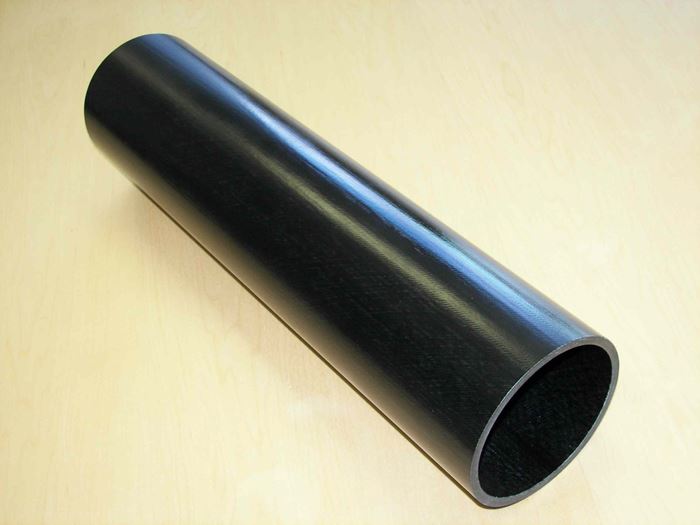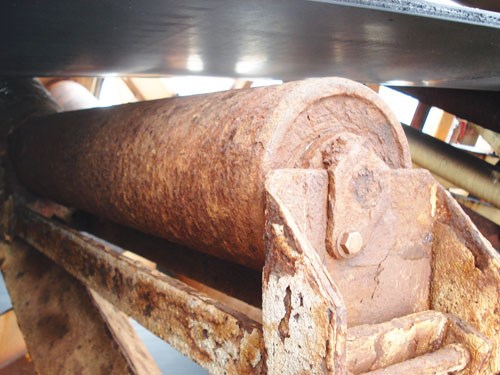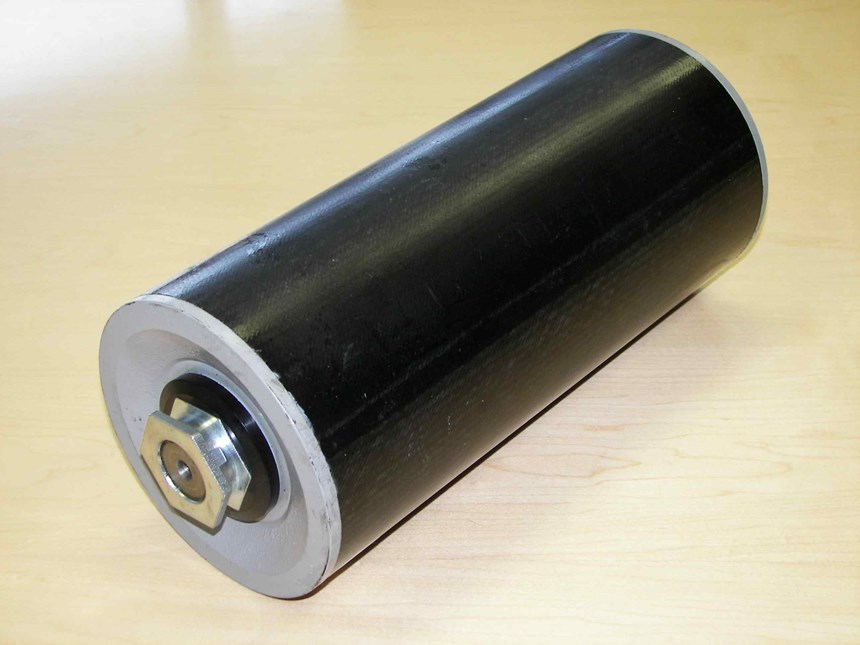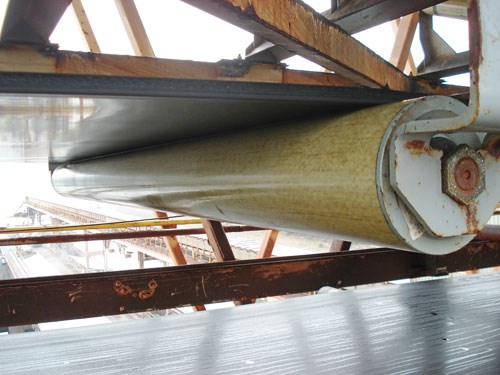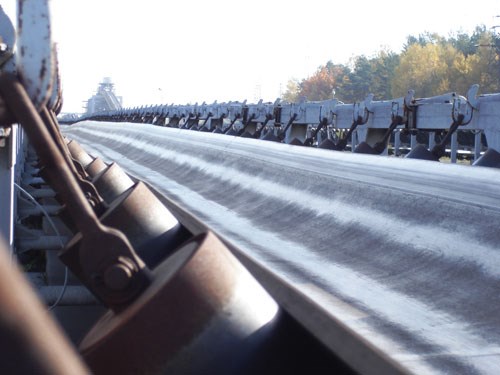Mining the potential of polyurethane composites
Pultruded rollers for mine conveyors outperform steel and portend a huge new market.
On a list of tough industries, mining ranks near the top. It’s also huge. Billions of tons of a diverse range of materials — abrasive, corrosive and challenging to handle — are extracted from the ground each year around the world, providing nearly half a trillion dollars, directly and indirectly, to the U.S. economy alone, according to the National Mining Assn. (Washington, D.C.). How those extracted materials are handled is an important part of mining economics and, says one California Energy Commission report, materials handling equipment can make up as much as 50 percent of all mine costs.
It’s also a huge potential market for composite materials. One company is hoping its corrosion-resistant composite conveyor rolls will be a breakthrough product for improved materials handling. RS Technologies (Calgary, Alberta, Canada), a wholly-owned subsidiary of nearby Edmonton-based Resin Systems Inc. (RSI), together with partner FMC Technologies Inc. (Tupelo, Miss.), is in the process of developing a composite idler roll — a tubular roller, 5 to 7 inches (125 to 175 mm) in diameter and up to 72 inches/1.85m long that would replace mild steel roller components on mining conveyor belt systems that can be many miles in length. “We’re talking about an extreme service product,” says RSI’s president and CEO, Paul Giannelia. “These rollers can perform under highly abrasive, highly acidic and extreme temperature conditions and save mine owners significant repair and maintenance costs compared to steel.”
It starts with the resin
In the mid-1990s, RSI developed its own proprietary polyurethane resin system. The tough, impact-resistant, two-component formulation has been optimized for RS Technologies’ filament winding and pultrusion processes, which are focused on producing utility and industrial products marketed under the trademarked RStandard name (see “Editor's Picks,” at right).The conveyor roll concept, which comprises a composite tube body and a steel head/shaft/bearing assembly that enables its rotation, grew out of several previous partnerships and development projects, including soil ties for slope control, as RSI focused on a long-term industrial application with solid growth potential, says Giannelia. “The mining industry is interested in a solution to corrosion, particularly in iron and copper mines, potash mines or locations near saltwater,” he contends, noting that corrosive environments can reduce the life of a steel roll by 60 percent or more.
“Traditional steel rolls might have to be replaced as frequently as every two weeks in severe cases because of excessive rust,” Giannelia says, resulting in more frequent downtime, repeated capital expenditures for replacement rolls and a lot of labor costs for maintenance. Conveyor suppliers have tried coating steel rolls to extend their lives and have replaced them with unreinforced plastic rolls, but coatings can delaminate easily from the steel roll body, and plastic rolls aren’t as strong as steel rolls.
Working with partner FMC Technologies, a global conglomerate and a leading provider of material handling systems for many types of industries, RS Technologies is currently demonstrating the low total ownership cost of composite rolls to the materials handling industry with pilot installations in highly abrasive and corrosive environments.
It’s not an easy task in a very conservative industry, says Jim Calhoun, FMC’s director of sales and marketing: “Our job is to educate mining customers and let them know the benefits — old purchasing and procurement processes have to be overcome. It’s going to take a little time.”
The benefits of the composite rolls over steel rolls include
- much less susceptibility to abrasion and corrosion.
- from 30 to 50 percent lower weight than steel and the same strength at identical size, making it easier for workers to lift and install them.
- a lower coefficient of thermal expansion (CTE) and resulting lower expansion and contraction, which means less chance for the roll to go out of round, become unbalanced and put uneven loads on the bearings.
- the ability to bear higher belt speeds and rotation rates with less noise because of their lower weight.
- compliance with mining regulations for static and flame resistance, which makes them appropriate for both aboveground and underground installations.
While upfront cost is higher than a mild steel roll, Calhoun notes that the payback in longer life and decreased maintenance over time justify the investment. The benefits also can cascade throughout the entire conveyor system, adds Giannelia: “The conveyor infrastructure can be built with less material and, thus, be more cost-effective, since the total system weight can be significantly reduced using composite rolls. The conveyor system, being lighter, is also easier to start up from a dead stop by the conveyor’s electric motors.”
Tough tube technology
The roll tubes are pultruded at RS Technologies’ Calgary facility. “Pultrusion with polyurethane is a somewhat esoteric process,” says Giannelia. “Very few companies are able to do it successfully.” Because of the fast reactivity and short pot life of the two-part resin, line speed is much faster than traditional pultrusion lines that use conventional thermoset resins.Unidirectional fiberglass rovings and two or three layers of stitched glass mat, arranged in a proprietary fiber architecture, are pulled into a co-injection die. The two resin components are mixed at a 1:1 ratio together with a carbon black filler and are injected at low pressure into the die to wet out the fibers (the carbon is required for static conductivity to meet underground mine regulations). The wetout reinforcements are then pulled around a tubular mandrel to create tubes in 5-inch/127 mm, 6-inch/152 mm or 7-inch/178 mm diameters. Cure takes place in a matter of minutes, and the tubes are typically cut to 20-ft/6.1m lengths. The finished tube wall thickness is 7.9 mm/0.3 inch, says Giannelia.
The pultruded tubes are currently being marketed for idler rolls, that is, those rolls underneath the conveyor belt that support the unloaded belt on its return path. Idler rolls are typically ganged together in groups of three or more and supported by a steel framework.
FMC uses computer analysis tools to design its customers’ conveyor systems, including the idler rolls, which are dependent on the type of mine operation, distances to cover, and type of material and overall tonnage, and then develops the specifications, including line width and speed, which dictate the roll size and bearing setup, says Calhoun. FMC cuts the tubes to the length dictated by the specific project’s design and combines them with the appropriate head and roller bearing for each conveying system.
A typical 6-inch/152-mm diameter composite return roll weighs approximately 35 to 40 percent less than a comparable steel roll, according to Calhoun, but he points out that although the composite tubing offers numerous advantages, focused attention is also required on the metallic bearing/seal assemblies located in the ends of each roll: “Composite tubing offers the ‘wow’ factor, but you still need the complete package for the idler roll to perform in harsh conditions — we have done a lot of work and research on building a better solution for the complete roll package.”
That work included extensive testing on press-fitting the idler head into the composite tubing. A study that included considerable in-house testing and prototyping led to a unique interference press-fit-and-gluing process that secures the head in the end of the composite tube. In addition to proper head insertion, FMC Technologies also has focused heavily on seal design to protect the idler roll bearings from abrasive and corrosive conditions.
Calhoun says the company has spent time and resources to ensure that the idler rolls meet all applicable Conveyor Equipment Manufacturers Assn. (CEMA) regulations. CEMA Standard 502 lists standards for load ratings for bearings and rolls, with “B” the lightest grade and “F” the heaviest, explains Calhoun. The results of FMC tests carried out on the composite rolls exceeded the published CEMA ratings for strength and durability, and comparisons to competing designs in unreinforced plastics like polyvinyl chloride (PVC) and high-density polyethylene (HDPE) show better overall performance by the composite roll. For example, PVC and HDPE rolls do weigh somewhat less than the composite versions, but they are less resistant to deflection in service at longer roll lengths than are the composite rolls, notes Giannelia.
So far, the composite rolls have been placed in several pilot projects in unidentified aggregate, potash, iron ore and coal environments, says Calhoun, and they have successfully performed more than 18 months in one test against other brands, with no failures. Orders for the rolls are beginning to come in, and the official product launch should occur sometime this year.
“Steel rolls have their place and can last for many years in the right conditions,” says Calhoun. “What we’re targeting are critical conveyors in high-maintenance situations. That’s where composites can increase handling productivity, decrease worker stress and cut costs by minimizing downtime, and create real benefit for the industry.”
Related Content
Composites end markets: Sports and recreation (2025)
The use of composite materials in high-performance sporting goods continues to grow, with new advancements including thermoplastic and sustainability-focused materials and automated processes.
Read MoreCombining multifunctional thermoplastic composites, additive manufacturing for next-gen airframe structures
The DOMMINIO project combines AFP with 3D printed gyroid cores, embedded SHM sensors and smart materials for induction-driven disassembly of parts at end of life.
Read MorePlant tour: Sekisui Aerospace, Orange City, Iowa, Renton and Sumner, Wash., U.S.
Veteran composites sites use kaizen and innovation culture to expand thermoplastic serial production, 4.0 digitization and new technology for diversified new markets.
Read MoreDevelopment of a composite liquid hydrogen tank for commercial aircraft
Netherlands consortium advances cryogenic composites testing, tank designs and manufacturing including AFP, hybrid winding, welding of tank components and integrated SHM and H2 sensors for demonstrators in 2025.
Read MoreRead Next
Composites on the Line
Electric utilities are ripe for conversion from wood power poles and cross-arms and steel-cored conductive cables to composite constructions, but most must still be persuaded.
Read MoreUser-friendly resins expanding composites' reach
Novel niche formulas enable composites breakthroughs for new market applications, traditional material replacement.
Read MoreNext-gen fan blades: Hybrid twin RTM, printed sensors, laser shock disassembly
MORPHO project demonstrates blade with 20% faster RTM cure cycle, uses AI-based monitoring for improved maintenance/life cycle management and proves laser shock disassembly for recycling.
Read More

